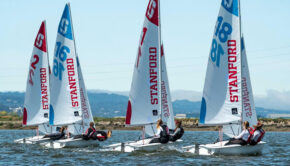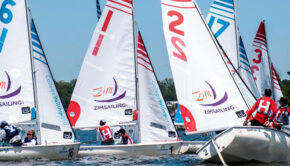College Sailing on Cloud Nine
Published on May 5th, 2014
The Course Croisiére EDHEC Sailing Cup is the biggest intercollegiate offshore regatta in the world, with the 46th edition in Les Sables-d’Olonne, France on April 25 – May 3.
Making the trip from USA was University of Chicago, Drexel University, Tufts (2 teams) and Georgetown. Canada also had two teams: University of Laval and HEC Montréal.
Andrew Mason was on the Georgetown University team, and provides this report on the event…
Even the casual reader of Scuttlebutt is aware of two topics endlessly debated on this newsletter: 1) “how do we build interest in sailing for the Xbox generation?” and 2) “how do we make college sailing in the United States simultaneously more competitive and more inclusive?” After a week at the 46th Course Croisiére EDHEC, there is perspective to be gained by looking across the pond at a college sailing model that is completely foreign to our own.
After winning the Intercollegiate Offshore Regatta at Larchmont Yacht Club this fall, a team representing Georgetown received a waived entry fee to compete at the CCE. From April 26th to May 3rd over 1,500 sailors primarily from France, but including teams from Switzerland, the United Kingdom, Poland, Belgium, Spain, Norway, the United States and Canada descended on Les Sables d’Olonne, of Vendee Globe Fame. Unlike our typical two day college sailing events, which by design are done with easy preparation by the host school and conducted over multiple venues for nearly a dozen weekends each semester, CC EDHEC brings 180 boats across three one design classes, J80s, Longtze boats and Grand Surprises, and three handicap divisions.
Like in the United States, the range of professionalism amongst the French teams at CC EDHEC varies. Stateside, big-name sailing schools like Georgetown, Tufts and College of Charleston enjoy a good deal of support from the university. Sailors at the top US programs follow a regiment akin to other varsity athletes and annual team budgets are well into the six figures. The top sailors will often go five or six regattas in a row without a weekend off. Obviously, this institutionalization and support varies across conferences and even across subsectors within conferences.
On the French side, the top teams are flashing corporate sponsors on their sleek jackets and new sails from the likes of KPMG, Total, Sopra Group and Altran. Meanwhile other teams were groups of friends with varying levels of sailing experience looking for competitive racing, a vibrant atmosphere and a roof-blowing party. After seven days, I think all of those bases were more than covered.
In my college sailing experience, when the races end, the event is usually over for the day. Because of the team-centered dynamic of college sailing, the institutional structures that surround college athletics and the mountain of studying that must get done after a long day on the water, the enjoyment of camaraderie amongst competitors often feels somewhat lost.
Of course much of this is for good and obvious reasons; athletic departments and universities must avoid the potential liability nightmare college partying entails. For better or worse, the simple post-race drink you buy a competitor that you “think” you crossed on port in Race 3A cannot exist.
On the water, Les Sables d’Olonne delivered with the conditions and the race committee was not hesitant to push competitors’ limits. Four of the six racing days saw breeze in the high teens to mid twenties coupled with huge, hull battering swells. The Grand Surprise and J80 fleets counted almost 40 entries apiece making for big starting lines, crowded mark roundings and some spectacular spinnaker ripping, fiber glass cracking, mast breaking, carnage. Having never sailed a J80 before the first race, our entire team was pushed to keep the boat in one piece and sailing fast.
After adrenaline filled, exhausting days on the water, après sailing takes on a whole meaning dockside. As the sails come down for the day, the regatta village, complete with sponsor tents, food tasting, beer bar, sun deck, video screen and a beach volleyball court, bursts to life. Short of the America’s Cup and Volvo Ocean Race stopovers, such an elaborate village has never been erected for a sailing event on American soil.
After the 9pm sunset, the après sailing in foulies migrates to an adjacent huge nightlife tent dedicated specifically for concerts featuring some DJ the average Scuttlebutt reader will never know. These dance parties stretch until the morning hours making several snoozes on the 6:30am iPhone alarm par for the course throughout the week. The morning after the opening party, I sheepishly asked one of the organizers from EDHEC Business School if there would be another party that night. In an accent that makes American knees melt for French girls she perplexedly replied, “of course there is… why wouldn’t there be a party every night?”
The Lollapalooza atmosphere meets intense conditions and competitive fleets of the CC EDHEC meant we were hammer down for a week straight. Our “Xbox generation” hates sitting idly and feeling our time is being wasted more than anything else. Unfortunately, in a sport where we are at the mercy of the wind gods our ADD is constantly tested. However, when we are full plane, kite reaching to the finish in 20+ knots or dancing until 2am our video games, Facebook profiles, and whatever else do not exist. We dialed in during racing and were able to decompress as college kids once the day was over.
Obviously American college sailing has its dozens of pluses and there are some pretty insurmountable hurdles for this CC EDHEC model to be adopted en-masse here. Would schools be able to sponsor varsity or even club teams if there is a party-type atmosphere associated with the event? Would college sailors be more eager to participate in fewer, larger events during long weekends and school breaks, instead of the current 12 to 18 boat, two-day, dinghy-focused events? Would incorporating more keelboat racing encourage or discourage people to join college sailing teams?
At the end of the day, if we were to take CC EDHEC as a model, we have to ask: would it keep more college aged kids interested and engaged in sailing both while in college and post-college? All the endless debate about keeping people in the sport always boils down to one word: fun. I am in no position of authority to say what should or should not be adapted from this model to our own college sailing system, but all I know is we sure had a f—ing blast experiencing how the French do college sailing.
###
The Georgetown University team finished 6th of 38 boats in the J80 fleet, which earned them a qualification into the GANT Final Race on seven-person Grand Surprises, where they finished 10th of 15. The team consisted of skipper John LaBossiere and crew Andrew Mason, Sam Oldroyd, Tucker Jones and Will Smith.
The Georgetown University team would like to thank Storm Trysail Foundation, The Tombs, The Corp, Chubbies Clothing, and others for their support and Thomas Gazeau and his team from EDHEC Business School for their incredible hospitality. The Georgetown University team also recognizes Maggie Bacon and Kathleen Kwasniak of Tufts University for their act of sportsmanship in joining their expanded crew for the GANT Final.










 We’ll keep your information safe.
We’ll keep your information safe.